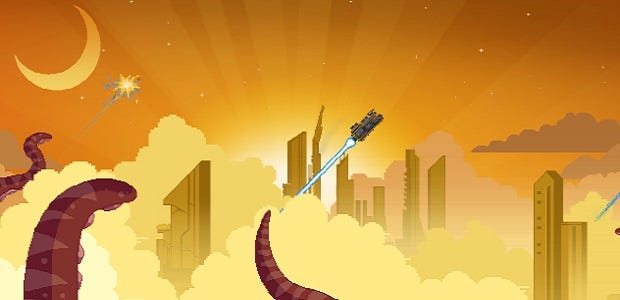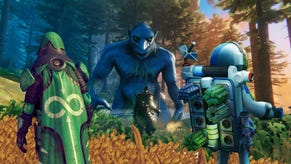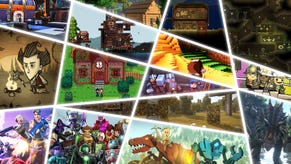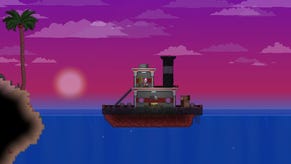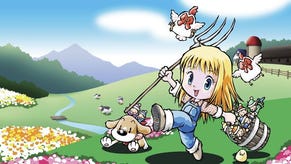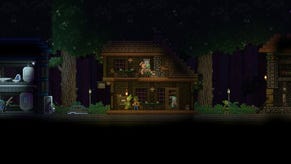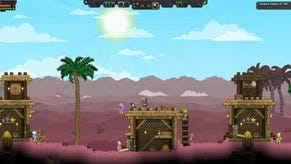Wot I Think: Starbound
Something for everyone
I’m a space cowboy made of stellar gas and I’ve spent the day farming. Starbound [official site] is a gargantuan galactic playground jam-packed with gunfights, planet-hopping adventures and tomb raiding, but I’ve probably spent just as much tending to my crops, decorating and going on shopping sprees. I’m utterly content.
Though it started out as a game largely focused on mining alien worlds, Starbound has grown into a sprawling, multi-limbed sandbox with diversions leaping into view at every turn. There’s a Pokemon-inspired pet system, colonies to manage, an endless supply of worlds to explore, farming, customisable spaceships, you can start a band – it sometimes feels a bit out of control.
A good story could tie it all together. Not Starbound’s actual story, mind, because it sort just lingers in the background like a terribly shy party guest. Earth’s been blown up, there’s an ancient evil coming, get a bunch of artefacts and put a stop to it. No rush, though. It doesn’t help with cohesion at all, but it does at least serve as the impetus to push on to increasingly more dangerous – and rewarding – worlds.
Back in 2013, when Starbound first launched on Early Access, it had a hypnotic rhythm. During the day: build higher and higher. During the night: dig deeper and deeper. There was a steady sense of progression accompanied by the sound of pickaxes. It’s harder to hear now.
I have a quest log overflowing with the same few tasks repeated, wheat to harvest, crops to water, an Apex (space monkeys) base to infiltrate, potential crewmates to recruit, and I’ve been pondering the possibility of adding another tower to my intimidating castle/holiday home. The rhythm is still there, though. That’s why a day might go by where I’m mostly indulging my green thumb. Starbound might be a bit scattershot, but it doesn’t force you to play that way.
Digging great big holes down to the centre of a planet and carving out underground bases or frontier homesteads remains my favourite pastime. I’m more likely to clear out a hostile stronghold so I can demolish it and use the parts to upgrade my home than save another bunch of feckless prisoners.
Spending a few hours hunting down a specific type of panel for my next building project is now what I consider a fun evening. Given that I’m actually redecorating my own home in real life, subjecting myself to that in a game just seems a wee bit sick. But Starbound has a bounty of themed architecture and furniture – craftable and available for nicking – that tickles the imagination. After visiting a few planets, you’ll look at your rubbish hut and think: nothing less than an underwater pagoda with a secret subterranean lab will sate me. That’s how it gets you.
The main quest and infinite supply of regurgitated side quests tend to fall by the wayside as I embark on my own personal adventures. Sure, the galaxy is in peril, and also some robotic knight needs me to tell another robotic knight that he likes him, but I’m kind of busy collecting tapestries for the new library. Being house proud is motivation enough to explore.
Maybe that’s what really ties Starbound together: the joy of acquiring more stuff for your home. Certainly, it’s the only reason I actually do anything. Fighting giant monsters? Looking for a new table. Breaking into catacombs built from bones? Foyer needed a statue. Surrounded by monsters in a pitch black cave? I wanted a new stetson because I was thinking of building a ranch. Greater purpose has been given to these building projects through the colony system, though. Legitimate excuses to keep making more towers, bunkers and luxury villas. Put together a functioning home, purchase a colony deed and slap it on the wall, and instantly a new colonist will pop into existence.
While NPCs have a tendency to get stuck or trapped by monsters, the system itself is considerably smarter. It’s the furniture that determines what type of colonist appears. One of my first buildings, a haphazard medieval tower, got snatched up by a Glitch knight, one of those aforementioned robots. He now spends his days running around outside, hitting adorable but ferocious monsters. His name is Windpike and we’ve become best friends. If I’d constructed a lab, my first colonist could have been a hairy Apex egghead instead. Thank goodness it wasn’t, though, because we really did have a monster problem before Windpike moved in.
Experimenting with different objects and themes can unlock anything from mechanical kings to frontier bar owners. It’s yet another rabbit hole. I’m planning even more colony expansions as I type this – I can’t believe I don’t have a saloon yet – but like the vast majority of Starbound, all of this is far from compulsory. Aside from the satisfaction gained from turning an empty plot of land into a sort-of-functioning town, colonists pay taxes, so they’re a good investment if you’re saving up for a new hoverbike or flamethrower.
Starbound tries its hand at so much that it’s not remotely surprising to see it dabbling in Metroidvania-style dungeons, as well. The procedural nature of Starbound’s worlds result in messy planets that are fun to explore but frustrating to fight on. There’s no level design directing the action or creating interesting arenas, and enemies constantly get stuck. Developer Chucklefish’s solution to this is a series of curated dungeons littered throughout the main quest, where you’re forced to use dexterity and special abilities – like turning into a ball, Samus-style – to navigate the rooms and corridors. You can’t mine your way through them, either.
It feels a bit like one addition too many, and these specific dungeons take away the one tool that you always use: the matter manipulator. It’s a McGuffin that cuts through rock, demolishes buildings, sucks up liquids and moves objects. It would render all those traps and challenges meaningless, though, so it stops working temporarily. It’s a concession for something that doesn’t really fit in with the rest of the game, diverse as it is.
The freedom to make the game your own, selecting the parts that hook you, whether that’s building gaudy mystical pyramids or becoming a gun-toting space mercenary, is fundamental to Starbound; it’s what makes the scattershot approach work, and those boss dungeons are the antithesis of that. They make up only a tiny part of the galactic adventure, thankfully, and can be ignored for as long as you care to – but they do unlock new features and tempt with fancy rewards.
I once carried around a giant eyeball that shot out death rays, originally looted off the corpse of a boss. Was it worth fighting that boss three times? I don’t know… it was a pretty big eyeball.
Weather! I’m only blurting it out because I’ve just come back from a mid-review jaunt through my colony, and I’ve been reminded of some things that I swore I’d write down in case I forgot, and then promptly forgot. There are worlds plagued by showers of acid, others are battered by sandstorms, and on some it just rains a lot, making it feel like home. The impact of a storm is more than cosmetic – acid rain can kill and meteor showers deposit minerals on the planet’s surface. It’s far from the most important of the systems that keeps Starbound’s universe turning, but it adds some interesting wrinkles and another layer of authenticity to these alien orbs.
I vividly recall building a base with a chum on this lovely little planet we’d discovered, back in the first days of Early Access. Lots of minerals near the surface, a perfect spot for some construction, all the resources we’d need. There were a few pools of acid, but we didn’t care. It’s great for exfoliating. We felt differently after the first night of rain. But we persevered. We started building into the side of a mountain, making tunnels everywhere so we could avoid the frequent skin-melting showers, forced by the weather to change our plans entirely. We could have found another world, but the hostile environment had become part of the planet’s charm.
“Wouldn’t it be cool if…” is how I imagine most pitches for Starbound’s systems began. So many ideas have been flung against the wall, I doubt you could even see it anymore. Luckily, a lot of these ideas have turned out to be pretty cool in practice as well as on the whiteboard. And there’s unexpected depth to be found in things that just seem like diversions. When I first messed around with the colony system, for instance, I wasn’t prepared for the Gotta Catch ‘Em All-ness of Pokemon or the potential for colonies as diverse as military bases and treetop villages, buzzing with NPC activity.
I find it difficult to picture the person who wouldn’t enjoy Starbound. Parts, sure, but the whole is this sincere, incredibly ambitious sandbox that’s as full of charm, and space-faring pirate penguins, as it is stuff to build and places to explore. And whatever you do, if you decide to add this digital galaxy to your collection, make sure to blackmail some friends into picking it up. Though Starbound multiplayer has been historically finicky to set up, it undoubtedly benefits from being played by an intrepid crew. And if you need a new drummer, you can make them join your band, too.
Starbound leaves Early Access tomorrow, and is available for Windows, Linux and Mac.
